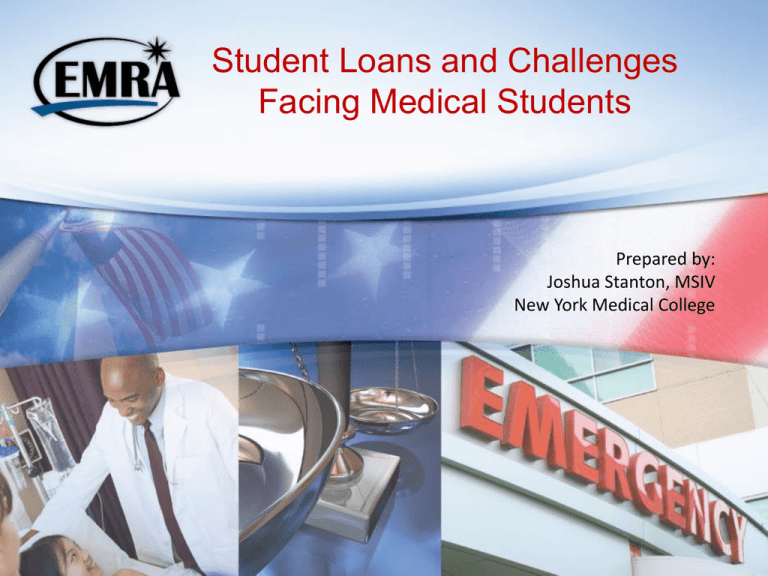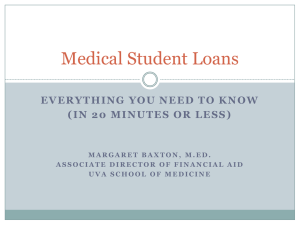Student Loans and Challenges Facing Medical Students
advertisement

Student Loans and Challenges Facing Medical Students Prepared by: Joshua Stanton, MSIV New York Medical College Objectives • • • • • • Loan Types Consolidation Forbearance and Deferment 20/220 and IBR Problems with IBR Solutions Student Loans • Financial aid packages that are required to be repayed and often acquire interest while open • 3 Primary Types: – Stafford Loans – PLUS Loans – Private Education Loans Stafford Loans • Stafford loans are federal loans made directly to the student. • These loans are then further subdivided into Subsidized and Unsubsidized – Subsidized loans accrue interest that is paid by the Federal government. – Unsubsidized loans accrue interest for which the student is responsible. • There are lifetime limits on both Subsidized ($65,000) and Unsubsidized ($224,000) loan PLUS and Private Loans • PLUS - Federally sponsored student loans – Supplemental to Stafford • Private loans can be also bridge gaps – Subprime crisis – Decline in the economy – Decreased lenders providing these loans With Graduation Comes so Many More Problems Loan consolidation and other avenues of repayment Loan Consolidation • May have multiple educational loans to pay • Consolidation allows a student to combine several loans into one big loan • Consolidation is available for most federal loans – Some restrictions do exist: • • • • Students cannot consolidate while attending school Married couples cannot consolidate together Loans can be consolidated only once Additional loans must be added to be reconsolidated Deferment and Forbearance • Deferment – postponement of payments with interested paid by the government: – Graduate program – Unemployment – Economic hardship • Income-Based Repayment became law in 2008 that made deferment near impossible • Forbearance – postponement of payments with interest accruing to the student 20/220 Pathway and the Income-based Repayment • 20/200 Pathway was the old system – Resident qualified for deferment if they were: • Employed full time • If their debt burden is greater than 20% of their income • If their income (minus their debt burden) is not greater than 220% of the federal poverty level. • As of July 1, 2009 the 20/200 pathway was replaced by the Income Based Repayment (IRB) system. Income Based Repayment (IBR) • Requires payments based on a percentage of income • Rationale – Encourage payment on loans and prevent large debt burden – Medical school unique with low-paying residency – Not considered in blanket approach passed to cover all graduate programs IBR 10 Year Plan • Once in Residency: – Work for non-profit entity for 10 years – Pay IBR calculated payment for 10 years – After which, the remainder of loans are forgiven • The good news: Residency, Fellowship, and most hospitals count as non-profits. • The Bad news: Once an attending, have to pay on the 10 year plan, thus limited utility Loans Eligible for IBR • Federal Direct Unsubsidized Stafford Loans • Federal Direct Subsidized Stafford Loans • Federal Direct PLUS Loans for parents and grad/professional students • Federal Direct Consolidation Loans Concerns and Solutions • The average American medical student graduates from school with 126,000 dollars • Average Resident salary is 46,000 • Even minimal payments difficult for some residents in urban settings Possible Solutions and Objectives • Permanent reinstatement of the 20/200 Pathway • Expansion of the Hardship Deferment Criteria • Return of in-school consolidation • Increases in federal grant aid • Reduction of IBR mandated repayment percentage Conclusions • Graduate Education is Very Expensive • Loan Repayment options are no longer as favorable • IBR System can be very challenging for residents • New systems with better adaptability to individual conditions will be needed Online Resources • Calculator available to estimate amount of IBR payment and borrower eligibility: www.studentaid.ed.gov • NSLDS available to borrower to obtain complete Federal student loan information www.NSLDS.ed.gov Resources for you Decision Making 1. National Student Loan Data Systems for Students http://www.nslds.ed.gov 2. Federal Direct Loan Home Page http://www.ed.gov/offices/OSFAP/DirectLoan 3. Free Application for Federal Student Aid (FAFSA) http://www.fafsa.ed.gov 4. Association of American Medical Colleges http://ww.aamc.org 5. American Medical Association http://www.ama-assn.org 6. The Smart Student Guide to Financial Aid http://www.finaid.org 7. Sallie Mae http://www.salliemae.com 8. Nellie Mae http://www.nelliemae.com






